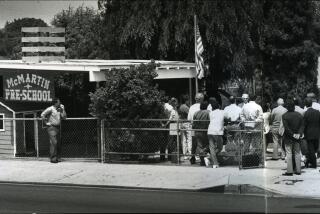Macabre Humor Helps Some Defuse Kraft Trial Horrors
- Share via
The enlarged photographs of dead bodies had been flashing on the courtroom movie screen for about nine weeks, and yet the judge and jury in the Randy Steven Kraft mass murder trial appeared to have retained a sense of humor.
In the middle of testimony on the infamous “death list,” the judge, who has a bad back, coughed so violently that a foam rubber brace popped right off his neck. But when he caught his breath, Superior Court Judge Donald A. McCartin joked: “Strangulation right here.”
The jurors howled in amusement.
Strangulation, of course, was just how most of the 16 victims in the case met their grisly ends.
The first day I attended the Kraft trial, while filling in for another reporter, I was overcome by what I saw. All that night, images of bruised and battered young men kept floating through my head, until I promised myself that I would not look at any more pictures, no matter how long I covered the trial.
But the next day, I looked again. And two weeks later, when the judge made his strangulation joke, I found that I was laughing with all the rest.
Perhaps one reason we could laugh was that none of us knew the victims. But there were other reasons.
The sheer volume of victims, for one, is numbing. It seems impossible that any one person could have killed them all.
Although Kraft is on trial in just 16 slayings, prosecutors have said he is connected with at least 21 others. And if that isn’t enough, police believe that he may be responsible for 28 more--a total of 65.
Also, there were the expert witnesses whose cold, clinical jargon made the courtroom proceedings seem more like an introductory class in human pathology than a mass-murder trial.
The garish purple bruises on the young men’s necks were “ligature marks,” they said. The blood streaming out of the victims’ noses was “edema fluid,” the bloody effluent spewed out by the lungs in the last moments of strangulation.
The experts even managed to strip some of the horror from the emasculations, as they patiently explained how one could tell whether castrations had occurred “ante-mortem” (before death) or “post-mortem” (after death) by the presence or absence of blood.
And finally, there is the smiling defendant, who is as appreciative of the judge’s gallows humor as anyone in the courtroom.
Kraft’s fastidious appearance and unfailing good cheer seems impossible to connect to so much brutality.
I left the courtroom that day still thinking of the judge’s strangulation joke, both amused and appalled.
I thought of how routine the trial is becoming. But then I remembered something the mother of one of the victims had said to me.
She had not missed a single day of the trial. She had seen every photograph and heard every expert witness. Perhaps she too had even chuckled at the judge’s remark.
One day, as the jurors were laughing and chatting during a break in the trial, I asked her if it all hadn’t begun to seem a bit unreal.
She looked at me with a faint smile and said: “They get out of here and they turn it off. But the victims, we can’t turn it off. We go home and it’s still there. The heartache is still there.”
More to Read
Sign up for Essential California
The most important California stories and recommendations in your inbox every morning.
You may occasionally receive promotional content from the Los Angeles Times.










